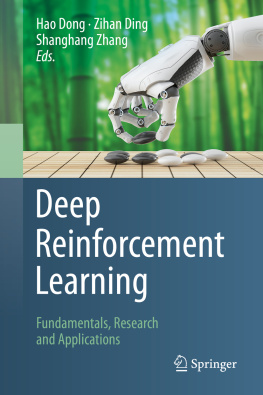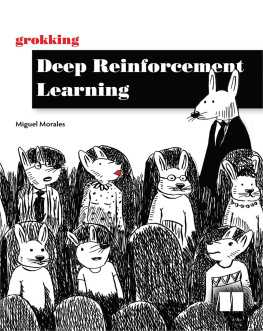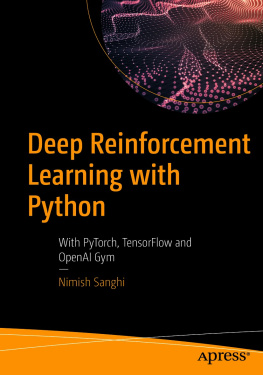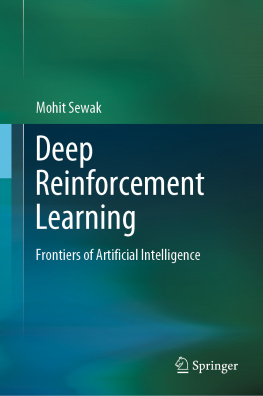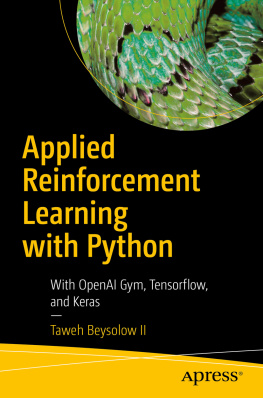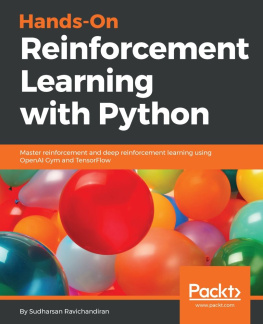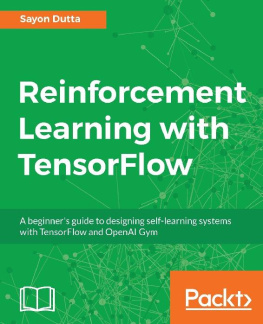Editors
Hao Dong , Zihan Ding and Shanghang Zhang
Deep Reinforcement Learning
Fundamentals, Research and Applications
Editors
Hao Dong
EECS, Peking University, Beijing, China
Zihan Ding
CS, Imperial College London, London, UK
Shanghang Zhang
EECS, University of California, Berkeley, Berkeley, USA
ISBN 978-981-15-4094-3 e-ISBN 978-981-15-4095-0
https://doi.org/10.1007/978-981-15-4095-0
Translation from the English language edition: Deep Reinforcement Learning by Hao Dong, Zihan Ding and Shanghang Zhang Copyright Springer Nature Singapore Pte Ltd. 2020.All Rights Reserved.
Springer Nature Singapore Pte Ltd. 2020
This work is subject to copyright. All rights are reserved by the Publisher, whether the whole or part of the material is concerned, specifically the rights of translation, reprinting, reuse of illustrations, recitation, broadcasting, reproduction on microfilms or in any other physical way, and transmission or information storage and retrieval, electronic adaptation, computer software, or by similar or dissimilar methodology now known or hereafter developed.
The use of general descriptive names, registered names, trademarks, service marks, etc. in this publication does not imply, even in the absence of a specific statement, that such names are exempt from the relevant protective laws and regulations and therefore free for general use.
The publisher, the authors and the editors are safe to assume that the advice and information in this book are believed to be true and accurate at the date of publication. Neither the publisher nor the authors or the editors give a warranty, expressed or implied, with respect to the material contained herein or for any errors or omissions that may have been made. The publisher remains neutral with regard to jurisdictional claims in published maps and institutional affiliations.
This Springer imprint is published by the registered company Springer Nature Singapore Pte Ltd.
The registered company address is: 152 Beach Road, #21-01/04 Gateway East, Singapore 189721, Singapore
Foreword
I am impressed by the breadth of topics covered by this book. From fundamental underlying theory of deep reinforcement learning to technical implementation with elaborated code details, the authors devoted significant efforts to provide a comprehensive description. Such a style makes the book an ideal study material for novices and scholars. Embracing the open-source community is an indispensable reason for deep learning to have such a rapid development. I am glad that this book is accompanied by the open-source code. I believe that this book will be very useful for researchers who can learn from such a comprehensive overview of the field, as well as the engineers who can learn from scratch with hands-on practice using the open source code examples.
FREng MAE Director of Data Science Institute Yike Guo
Imperial College London
London, UK
This book provides the most reliable entry to deep reinforcement learning, bridging the gap between fundamentals and practices, featuring detailed explanation and demonstration of algorithmic implementation, offering tips and cheat sheet. The authors are researchers and practitioners from leading universities and open source community who conduct research on deep reinforcement learning or apply its new techniques in various applications. The book serves as an extremely useful resource for readers of diverse background and objectives.
Director of the Center on Frontiers of Computing Studies Baoquan Chen
Peking University
Beijing, China
This is a timely book in an important areadeep reinforcement learning (RL). The book presents a comprehensive set of tools in a clear and succinct fashion: covering the foundations and popular algorithms of deep RL, practical implementation details, as well as forward-looking research directions. It is ideally suited for anyone who would like to learn deep RL, to implement deep RL algorithms for their applications, or to begin fundamental research in the area of deep RL.
Princeton University Chi Jin
Princeton, NJ, USA
This is a book for pure fans of reinforcement learning, in particular deep reinforcement learning.
Deep reinforcement learning (DRL) has been changing our lives and the world since 2013 in many ways (e.g. autonomous cars, AlphaGo). It has showed the capability to comprehend the beauty of Go better than professionals. The same idea is currently being implemented in technology, healthcare and finance. DRL explores the ultimate answer to one of the most fundamental questions: how do human beings learn from interaction with environment? This mechanism could be a silver bullet of avoiding the big data trap, a necessary path towards Strong AI, as well as a virgin land that no human intelligence has touched before.
This book, written by a group of young researchers with full passion in machine learning, will show you the world of DRL and enhance your understanding by means of practical examples and experiences. Recommend to all learners who want to keep the key to future intelligence in their own pocket.
University College London Kezhi Li
London, UK
Preface
Deep reinforcement learning (DRL) combines deep learning (DL) with a reinforcement learning (RL) architecture. It has been able to perform a wide range of complex decision-making tasks that were previously intractable for a machine. Moreover, DRL has contributed to the recent great successes in artificial intelligence (AI) like AlphaGo and OpenAI Five. Indeed, DRL has opened up many exciting avenues to explore in a variety of domains such as healthcare, robotics, smart grids, and finance.
Divided into three main parts, this book provides a comprehensive and self-contained introduction to DRL. The first part introduces the foundations of DL, RL and widely used DRL methods and then discusses their implementations, which includes Chaps. presents a rich set of applications, such as the AlphaZero and learning to run, with detailed descriptions.
The book is intended for computer science students, both undergraduate and postgraduate, who would like to learn DRL from scratch, practice its implementation, and explore the research topics. This book might also appeal to engineers and practitioners who do not have strong machine learning background but want to quickly understand how DRL works and use these techniques in their practical applications.
Acknowledgements
The authors would like to thank the people who provided feedback and suggestions on the contents of the book, including: Jie Fu from Mila, Jianhong Wang and Shikun Liu from Imperial College London, Kun Chen from Peking University, Meng Song from University of California, San Diego, Chen Ma, Chenjun Xiao and Jingcheng Mei from University of Alberta, Tong Yu from Samsung Research, Xu Luo from Fudan University, Dian Shi from University of Houston, Weipeng Zhang from Shanghai Jiaotong University, Yashu Kang from Georgia Institute of Technology, Chenxiao Zhao from East China Normal University, Tianlin Liu from Friedrich Miescher Institute, Gavin Ding from Borealis AI, Ruilong Su from Xiaohongshu Technology Co., Ltd., and Yingjun Pei from Chinese Academy of Sciences. We also want to thank Jared Sharp for the language proofread of most chapters in the book.

